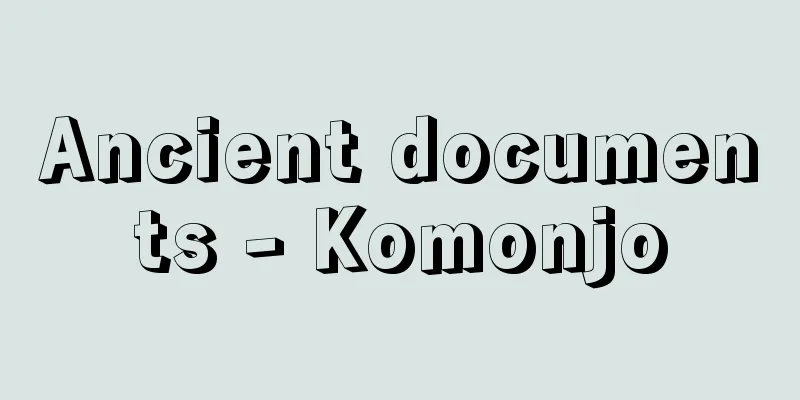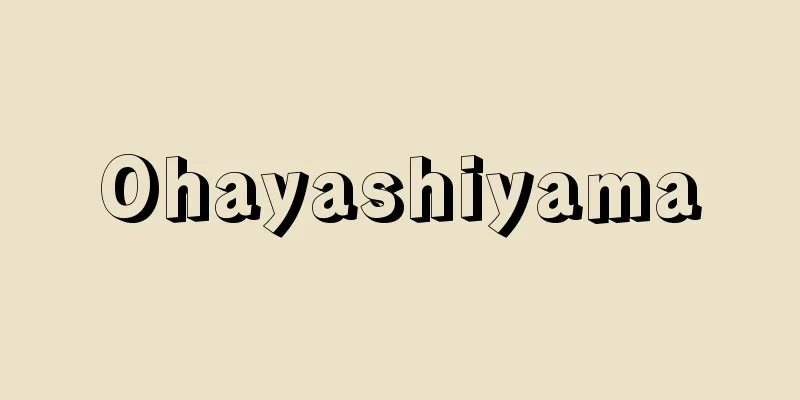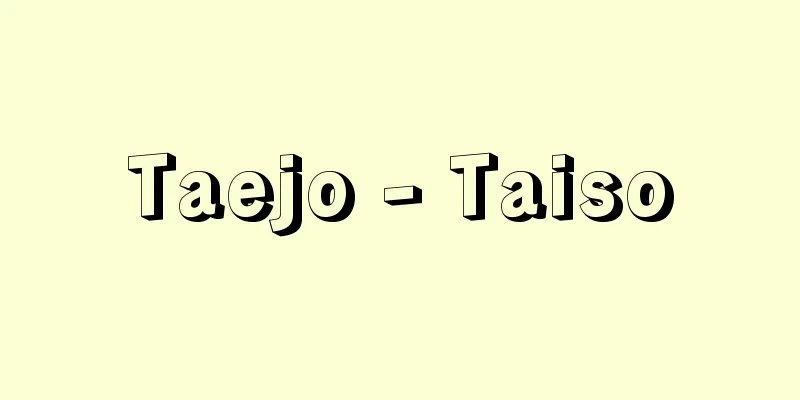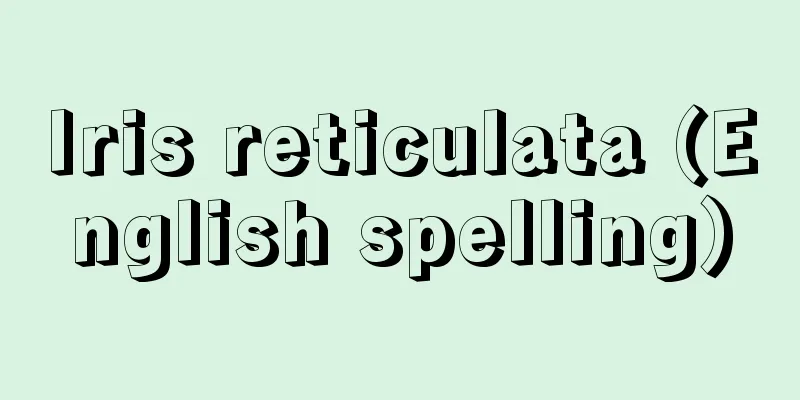Ancient documents - Komonjo

|
One of the historical documents. [Chijiwa Toru] Definition and scope of archival documentsAccording to the current definition by Katsumi Kuroita and Hisaichi Igi, it is a document created by a first person (sender) to convey some intention to a second person (recipient). In this case, it is said that it does not include ancient records such as diaries, or classics such as scriptures and books. Of course, it is not uncommon to use the term "komonjo" more broadly as a general and convenient concept to include ancient documents, but this usage is not used in modern paleography. However, some people, such as Shinichi Sato, have recently taken the view that many documents intended for comparison and inspection, such as catalogs, ledgers, and court records, should not necessarily be understood as documents. On the other hand, although most of the materials for ancient documents are written on paper, this is by no means a necessary condition, and as long as they meet the above conditions, it does not matter whether they are written on wood or carved into stone, and all should be considered ancient documents. For example, one example of the former is that a large portion of the ancient wooden tablets that have been excavated in large numbers in recent years from the Heijo Palace site, the Fujiwara Palace site, and other places, are similar in purpose to the letters sent from later times, and an example of the latter is the Tagohi monument in Kozuke Province (a copy of an official document from the 4th year of the Wadō era).Furthermore, it is a well-known fact that in the Middle Ages, documents such as donations and official notices were sometimes written directly on wooden tablets and posted. [Chijiwa Toru] Documents and Archival DocumentsBy the way, there is a theory that documents that still have validity are called documents, and those that have already lost their practical validity are called ancient documents. However, considering that the term "ancient documents" was originally given to documents as historical materials, such a distinction is meaningless. In historical research, there is not much difference in meaning whether something is called an ancient document or a document. However, it is important to clarify what was called an ancient document in the Middle Ages. According to Hiroshi Kasamatsu, documents that were called "ancient documents" in the Middle Ages were documents issued by criminals, documents that were damaged or held without a legitimate history, and documents that could not prove a specific right in a dispute, in other words, documents that had already lost their value. It is particularly noteworthy that in the trials of the Kamakura Shogunate, documents "before the Heike clan," that is, documents from the Heike government or before, were deemed to be "ancient documents" and therefore did not qualify as evidence. [Chijiwa Toru] Classification of ancient documentsThe motivation for creating a document is to convey one's will to others, but the content of this communication of will naturally include more than simple communication, but also cases in which a superior issues an order to a subordinate, or recognizes a right, or a subordinate requests something from a superior. The style of writing a document varies according to each motivation, the era, or the status of the writer and the recipient. The purpose of classifying document styles is to analyze the different styles of writing and infer things that cannot be understood from the content of the document alone (such as determining the era, or the status and relationship between the writer and the recipient). Methods for classifying document styles vary slightly depending on the researcher, but the method used by Sato Shinichi is as follows. Sato claims to classify documents into six types, adding three more types: (4) certificates, (5) documents dedicated to gods and Buddhas, and (6) letters, to the three types based on historical changes in style: (1) official style (kushikyo), (2) court noble style (kugeyo), and (3) samurai style (bukeyo). A brief explanation of these types is provided below. (1) Official Documents: Official documents in the format prescribed in the official Yoro Code. The official code stipulates that documents are sent from the top down, such as imperial edicts, orders, and proclamations, and that documents sent from the bottom up are called shosho, ryoji, and fu, and that documents sent from the bottom up are called iwai, cho (later to be used as documents issued by government officials outside the code), ji, and ge. (2) Documents of Courtiers In the Heian period, new styles of documents appeared as the Ritsuryo system collapsed and regents, chancellors and retired emperors became the center of politics. The main ones were senji, kudashibumi (substitute for official letters), chosen (official decrees) instead of kokufu (national seals), and hosho (official letters) documents that developed from the style of letters in which a yuhitsu (right-hand man) was the formal sender (if the actual sender was the emperor, it was called rinji, if the retired emperor, it was called inzen, if the imperial family, it was called reishi, and if a nobleman of third rank or higher, it was called migyosho). (3) Samurai Documents These came into being and developed after the establishment of the Kamakura Shogunate. There are documents such as official documents, such as shimbun (public orders), gechijo (imperial orders), jikijo (direct letters, stamps, etc.), hosho (imperial orders, magistrate's hosho), and inpanjo (seals), as well as documents for the promotion of affairs, such as moshijo (petitions), chushinjo (reports), ukebumi (applications), and gunchujo (military loyalty letters). (4) Documents: These include letters of assignment, sales tickets, contracts, and letters of compromise. (5) Documents offered to the gods and Buddhas These include prayers and supplications to the gods and Buddhas, letters of commitment, vows made before the gods, and letters of donation used when offering assets. (6) Letters A document exchanged between private individuals, which was called a letter or a message in ancient times, and a message or a letter in the Middle Ages. Although a letter is a private document, it cannot be written freely. Rather, it was strongly required that the style of the letter be changed depending on the status and rank of the sender and recipient, and violation of this rule was considered disrespectful, so various collections of sample letters such as "ourai" and "shosatsurei" and explanations of the style were created and used. [Chijiwa Toru] Creating a documentIn the creation of a document, the general process is to first create a draft called a dodai, which is then revised and clean-up copied until the final text is complete. However, the details of the document creation process, such as who writes it and what type of paper is used, vary depending on the type of document. For example, in terms of the writer, if the sender is of a high rank, they may not even take up the pen themselves, even for a private letter, but may have a professional scribe called a yubitsu write it, and in the case of an official document, it is almost impossible for the de facto issuer to write it themselves. In the case of shimobun, the yubitsu simply places a kao (signature seal) on the document created by the yubitsu, and in the case of hosho and okyosho, the hosho is usually created by the hosho at the will of a higher-ranking person, and the hosho, as the formal sender, usually signs with "Nanibo Uketamawaru." Also, when we look at writing paper, not only do the types of paper used differ depending on the era and region, but different qualities of writing paper are sometimes chosen depending on the sender's rank and status. For example, the imperial edicts are generally written on a unique paper with a light ink color and a suki-reverse weave (shukushi), but this is only the case when the kurōdo (chief retainer) serves as the servant; when a benkan other than the kurōdo serves as the servant, regular white paper is used. By the way, the sender and the recipient of a document may differ on paper from the actual sender. We have mentioned earlier examples of senders differing in substance and form, but examples of recipients that are different include the following. There are many documents in which feudal lords or the shogunate order the shomin (manor) to follow the instructions of a newly appointed jito (land steward) or geshi (lower rank official), and in such documents, the formal recipient is usually the shomin themselves, usually written as "the peasants of a certain manor below ." However, in reality, the recipient of such documents is the jito or geshi who has been granted the rights, and the document itself is handed to the jito or geshi and left in his hands. [Chijiwa Toru] Preservation and transmission of ancient documentsDocuments are preserved and passed down in different ways depending on their function and effectiveness. Immediately after a document is created and transmitted, the first selection is made as to whether it should be preserved or not. For example, sales certificates, official documents, and donation letters that show the rightful ownership of land or a house are passed from hand to hand along with the land as the owner changes, and the documents are pasted on one after another (this is called succession). Such documents are carefully stored and organized by their owners so that they can be used immediately as evidence in the event of a dispute over ownership. If a document is lost by accident, a lost document must be created to replace it. On the other hand, there are some religious documents for which the original text is not preserved. These include the pledges written when Ichimi Shinsui was used, and the declarations made by the emperor to report to his ancestral shrine or tomb. These were read out before the gods and then burned to ashes, so the original texts were not preserved. This was because it was feared that the documents would be defaced later, and because burning the documents was thought to be a way of conveying the writer's will to the gods. Whether a document is preserved or not is also determined by the next generation. In other words, even if an old document has passed a certain period of time and lost its original effect, it may acquire another value. For example, it may have antique value or be useful in asserting the age or nobility of a family. Many old documents remain today because of this value. On the other hand, some documents have survived by chance because they were not found to have any value. For example, there are documents on the backs of papers that were discarded and used as paper for copying sutras or diaries. The reason why so many documents from the Nara period remain in Shosoin is because documents from government offices were donated to Todaiji Temple as paper for copying sutras. Also, a large number of medieval documents were discovered in 1984 at Tokuzenji Temple, a subtemple of Daitokuji Temple in Kyoto, and they survived because they happened to be used as lining for sliding doors. These documents, unlike those that were meant to remain, often contain valuable historical materials that give us a glimpse into the real lives of people in the past. [Chijiwa Toru] Use and preservation of historical documentsThe value of ancient documents in modern times can be broadly divided into two categories: their value as antiques or in terms of appreciation, and their value as historical materials. A typical example of the former is a tea hanging scroll used in a tea house, while an example of the latter is the development of history through the publication of collections of ancient documents, which has become popular in modern times, especially after the war. The publication of collections of historical documents such as "Dai Nihon Shiryo" and "Dai Nihon Komonjo" from before the war, "Heian Ibun" and "Kamakura Ibun" edited by Takeuchi Rizo after the war, and prefectural and city histories compiled by local governments have opened the way for a wide range of historians to use ancient documents, who would not normally have easy access to the original documents, and have provided many new insights. In addition, in order to prevent the original documents from being lost, museums and archives in various regions have been collecting medieval and early modern documents related to their regions, making them much easier to use than before. On the other hand, while publishing has progressed in this way, while medieval documents that have antique value are one thing, the preservation and public access to documents from the early modern period onwards that have rarely been reprinted, especially the vast amount of administrative documents from the modern period onwards that are gradually becoming "archaic documents," has not progressed as expected. Some say that modern documents written on acidic pulp paper, which has a short life span, are at greater risk of disappearing than medieval documents written on Japanese paper, which has a long life span, and there is an urgent need to establish preservation measures. [Chijiwa Toru] "Japanese Ancient Documents, Volumes 1 and 2, by Aida Jiro (1949, 54, Iwanami Shoten) " "Introduction to Palaeography, by Sato Shinichi (1971, Hosei University Press)" "Outline of Palaeography, Ancient and Medieval Edition, edited by the Japanese Historical Association (1983, Yoshikawa Kobunkan)" [Reference] |©Shogakukan "> The closing words of a letter from the "Kōan Shosatsurei"… ©Shogakukan "> The closing words of a letter from the "Kōan Shosatsurei"… Source: Shogakukan Encyclopedia Nipponica About Encyclopedia Nipponica Information | Legend |
|
歴史資料の一つ。 [千々和到] 古文書の定義と範囲現在の通説である黒板勝美(くろいたかつみ)・伊木寿一(いぎひさいち)らの定義によれば、第一人者(差出者)が第二人者(受取者)に対してなんらかの意志を伝達するために作成した書類をいう。この場合、日記などの古記録や、経典、書物などの典籍は含まないとされる。もちろん、一般的・便宜的な用法としては、古文献を包括する概念として、古文書という語をより広く用いることもそれほどまれなことではないが、現在の古文書学ではこうした用法はとらない。もっとも、最近では佐藤進一(しんいち)のように、目録・帳簿や訴訟記録などの、照合・点検を目的とする文献の多くは、かならずしも文書と切り離さずに理解しようという考え方もある。一方、古文書の素材は、そのほとんどが紙に書かれているとはいえ、それはけっして必須(ひっす)条件ではなく、前述の条件さえ備えていれば、木に書かれていようと、石に刻まれていようとなんら問題とはならず、すべて古文書と考えるべきである。たとえば、前者の例としては、近年平城宮址(へいじょうきゅうし)、藤原宮址などから大量に出土している古代の木簡(もっかん)のうちのかなりの部分が、後世の送文(おくりぶみ)と同趣旨のものであることをあげることができるし、後者の例としては、上野国(こうずけのくに)多胡碑(たごひ)(和銅(わどう)4年官符写)のようなものをあげることができよう。さらに、中世には寄進状や制札などの文書が直接木札に記されて掲示されることがあったのは、よく知られた事実である。 [千々和到] 文書と古文書ところで、なお効力をもっているものを文書とよび、すでに実際上の効力を失ったものを古文書とよぶ、という説がある。しかし古文書ということばがもともと歴史資料としての文書に対してつけられた名称であることを考えれば、こうした区別は意味をもたない。歴史研究のうえで、あるものを古文書とよんでも文書とよんでも、それほど意味の違いがあるわけではない。ただし、中世においてなにを古文書と称していたかということは、はっきりしておくべきであろう。笠松宏至(かさまつひろし)によれば、中世において古文書とよばれたのは、罪科人の発給にかかる文書や朽損しあるいは正当な由緒なく所持している文書であって、相論(そうろん)などに際して特定の権利を証明しえない、すなわちすでに価値の失われた文書のことをさすという。とりわけ鎌倉幕府の裁判のなかで、「平家以往」つまり、平氏政権やそれ以前の文書は「古文書」であるので証文に足らずとされたということは注目に値するといえよう。 [千々和到] 古文書の分類文書作成の動機は、自分の意志を他者に伝えることであるが、その意志の伝達の内容には、単なる意志の疎通だけではなく、上の者が下の者になんらかの命令を行う場合、または権利を認定する場合と、下の者が上の者になにかを要請する場合も当然含まれる。そしてそれぞれの動機に応じて、またその時代、時代によって、あるいは書き手と受け手の地位の高下によって、その文書の書きようは異なるものである。そこで、その異なる書きようを分析することによって、文書の内容だけからではわからないこと(たとえば時代判別とか、書き手と受け手の地位や相互の関係など)を類推しようとするのが、文書様式の分類の目的である。 文書の様式分類法は研究者によって多少異なるが、佐藤進一の方法に従えば次のようになる。佐藤は、様式の歴史的変遷を踏まえた(1)公式様(くしきよう)、(2)公家様(くげよう)、(3)武家様(ぶけよう)の3種に、(4)証文、(5)神仏に奉る文書、(6)書状、の3種を加えて、6種に分類することを主張している。これらについて以下に若干の説明を加える。 (1)公式様文書 『養老令(ようろうりょう)』公式令のなかで規定された様式の公文書。公式令には上から下への文書として詔書(しょうしょ)・令旨(りょうじ)・符(ふ)、互通文書として移(い)、下から上申する文書として奏(そう)・牒(ちょう)(のちに令外官(りょうげのかん)などの発給文書として使われるようになる)・辞(じ)・解(げ)などが定められている。 (2)公家様文書 平安時代、律令制(りつりょうせい)が崩れ摂政(せっしょう)・関白や院が政治の中心になるにしたがって登場してきた新しい様式の文書。宣旨(せんじ)、符にかわる下文(くだしぶみ)、国符(こくふ)にかわる庁宣(ちょうせん)などや、右筆(ゆうひつ)が形式上の差出者となる書状様式から発達した奉書(ほうしょ)系の文書(事実上の差出者が天皇の場合は綸旨(りんじ)、上皇なら院宣(いんぜん)、皇族なら令旨、三位(さんみ)以上の公卿(くぎょう)なら御教書(みぎょうしょ)とよぶ)がおもなものである。 (3)武家様文書 鎌倉幕府の成立以降に発生、発展したもので、下文、下知状(げちじょう)、直状(じきじょう)(書下(かきくだし)、判物(はんもつ)など)、奉書(御教書、奉行人(ぶぎょうにん)奉書)、印判状(いんぱんじょう)などの下達文書と、申状(もうしじょう)、注進状(ちゅうしんじょう)、請文(うけぶみ)、軍忠状(ぐんちゅうじょう)などの上申文書とがある。 (4)証文 譲状(ゆずりじょう)、売券(ばいけん)、契状(けいじょう)、和与状(わよじょう)などが含まれる。 (5)神仏に奉る文書 神仏に祈願する告文(こうもん)・願文(がんもん)や、都状(とじょう)、さらに神前で誓いをたてる際の起請文(きしょうもん)、資財を奉納する際の寄進状などが含まれよう。 (6)書状 私人の間に取り交わされる文書で、古代に状(じょう)・啓(けい)とよばれ、中世には消息(しょうそく)・書札(しょさつ)などとよばれる。書状は私的な文書であるといっても、けっして自由な書き方ができるものではない。むしろ差出者・受取者相互の地位・身分によって文書の書きようを変えることが強く求められ、これに反したときは礼を失したものとみなされるため、各種の「往来(おうらい)」や「書札礼(しょさつれい)」といった書状の例文集、様式解説書がつくられ、利用された。 [千々和到] 文書の作成文書の作成にあたっては、まず土代(どだい)とよばれる草案がつくられ、これに手が加えられたうえで清書され、正文(しょうもん)が完成するのが一般的経過である。しかし、文書の種類によって、だれが書くのか、どんな紙を選ぶのか、といった文書作成過程の細かな部分は異なってくる。たとえば書き手であるが、差出者の地位が高ければ、私的な書状でさえも差出者自身は筆をとらず、右筆とよばれる専門の書記に書かせる場合があるし、公的な文書であれば、事実上の文書発給者自身が書くことはほとんどありえない。下文などでは、右筆の作成した文書にただ花押(かおう)を据えるだけであるし、奉書・御教書などでは、奉者が上級の者の意を受けて作成し、形式的差出者として奉者が「何某奉(なにぼううけたまわる)」と署名するのが一般である。 また、料紙(りょうし)をみると、時代・地域によって使われる紙の種類が異なるばかりでなく、差出者の地位・立場などによっては、異なった質の料紙が選ばれることもある。一例をあげれば、天皇の綸旨は一般に独特の漉(す)き返しの薄墨色をしたもの(宿紙(しゅくし))が多いが、それは蔵人(くろうど)が奉者を務める場合だけで、蔵人以外の弁官が奉者を務めるときは、普通の白紙が用いられるのである。 ところで、文書の差出者と受取者とは、文面上のそれと、実質的なそれとが違っている場合がある。差出者が実質と形式とで異なる例は前述したが、受取者が異なるのは、たとえば次のような場合である。すなわち、荘民(しょうみん)に対して新しく補任(ぶにん)された地頭(じとう)・下司(げし)の指示に従えと領主や幕府が命ずる文書はよくあるが、こうした文書の場合、通例、「下ス某庄百姓等(ぼうしょうひゃくしょうら)」などと、形式的な受取人は荘民たちになっている場合が多い。しかし、こうした文書は、現実には権利を付与された地頭・下司自身が受取者で、その文書自体、地頭・下司に手渡され、彼の手元に残されるものなのである。 [千々和到] 古文書の伝存と伝来文書は、その機能、効力によって異なった保存、伝存の仕方がなされる。文書に作成され伝達された直後に、まず残すか残さないかの最初の選別が行われる。たとえば、土地、家屋などの正当な所有者であることを示す売券、公験(くげん)、寄進状などは、所有者がかわるごとに土地とともに手から手へ移動し、引き継がれていくものであり、文書は次々と貼(は)り継がれていく(これを手継(てつぎ)という)。こうした文書は、いったん所有をめぐって相論が起きたときには、証拠としてただちに利用できるように、持ち主の手で厳重に保管、整理されているものである。もし万一事故で失われれば、紛失状が作成され、これにかわるものとされなければならなかった。一方、この反対に、ある種の宗教的文書では、正文を残さないものもある。一味神水(いちみしんすい)のときに書かれる起請文や、天皇が祖廟(そびょう)・山陵に報告する告文などがそれで、これらは神前で読み上げられたのち、焼かれて灰にされるから、本来正文は残されないことになる。これは、その文書がのちに汚されることをはばかったのと、文書を焼くことが書き手の意志を神に伝達する手段と考えられたからである。 文書が保存されるかどうかは、次の時代にも選別される。すなわち、古文書はある期間を過ぎ、その本来の効力を失っても、別の価値を生じることがある。骨董(こっとう)価値とか、家系の古さ、由緒正しさを主張するのに役にたつ場合などがそれで、こうした価値ゆえにいまに残っている古文書も少なくない。 一方、価値をみいだされなかったために、かえって偶然残された文書もある。たとえば反故(ほご)にして捨てられ、写経や日記の料紙に用いられたため残った紙背文書(しはいもんじょ)がそれである。奈良時代の文書が正倉院(しょうそういん)に大量に残されているのも、実は官衙(かんが)の文書が東大寺に写経用の料紙として献納されたためである。また1984年(昭和59)、京都大徳寺塔頭(たっちゅう)徳禅寺で発見された大量の中世文書は、たまたまそれがふすまの下張りに利用されたために残されたものである。こうした文書のなかには、残るべくして残った文書とは異なる、過去の人々の実生活をうかがうに足る好史料がしばしば含まれているものなのである。 [千々和到] 古文書の利用と保存現代における古文書の価値は、その骨董的価値、鑑賞上の価値と、歴史資料としての価値とに2大別されよう。前者の典型的な例としては、茶室に掛けられる一幅の茶掛けをあげることができようし、後者としては、近代以降とりわけ戦後盛んになった古文書集の出版による歴史学の発展をあげることができよう。戦前からの『大日本史料』『大日本古文書』はもとより、戦後の竹内理三(たけうちりぞう)編『平安遺文』『鎌倉遺文』や、地方自治体の編集している県史・市史などの史料集の刊行は、日ごろたやすく古文書原本に触れることのできない広範な歴史研究者に古文書の利用の道を開いたし、多くの新知見を提供してきている。また、古文書原本についても、その散逸を防ぐために、各地の博物館・文書館が地域にかかわる中世・近世文書の収集を進めており、以前よりはるかにたやすく利用することができるようになってきている。 しかし一方では、こうして出版が進み、骨董的価値もある中世文書はまだしも、ほとんど翻刻される機会のない近世以降の文書、とりわけしだいに「古文書」化しつつある膨大な量の近代以降の行政文書については、その保管と公開は思うように進んでいない。寿命の長い和紙に書かれた中世文書より、寿命の短い酸性のパルプ紙に書かれた近代の文書のほうが、より消滅の危険性が高い、という声もあり、保存策の確立は急務となっている。 [千々和到] 『相田二郎著『日本の古文書』上下(1949、54・岩波書店)』▽『佐藤進一著『古文書学入門』(1971・法政大学出版局)』▽『日本歴史学会編『概説古文書学 古代・中世編』(1983・吉川弘文館)』 [参照項目] |©Shogakukan"> 「弘安書札礼」による書状の書止め文言一… ©Shogakukan"> 「弘安書札礼」による書状の書止め文言一… 出典 小学館 日本大百科全書(ニッポニカ)日本大百科全書(ニッポニカ)について 情報 | 凡例 |
Recommend
Kapıkulu (English spelling)
The term "slaves" refers to the soldiers...
Corduliidae
...In Honshu, in addition to this subspecies, the...
Culex pipiens fatigans (English spelling) Culex pipiens fatigans
… [Takeshi Kurihara]. … *Some of the terminology ...
Hausa countries - Hausa countries
A group of Hausa nations established in northern N...
Ahbar - Ahbar
...They also do not accept any ijma (consensus) a...
ex libris (English spelling) exlibris
…In rare cases, pieces of leather are used. The L...
Golden peacock cedar - Golden peacock cedar
...The yellow-colored Kifuchabohiba is one of the...
Carissa
…It is an evergreen shrub of the Apocynaceae fami...
Administrative Investigation Department
...It was an external bureau of the former Prime ...
Onageru - Onageru
...In those days, the onager (an intermediate for...
Prairie - English spelling: prairie
The name of the vast grassland that spreads aroun...
Morning porridge - Asagau
〘 noun 〙 Rice porridge eaten in the morning. ※Uji ...
Alnoor - Alnoor
…He was a layman who became the Bishop of Metz (n...
opus magnum
…In Egypt, alchemy was thus linked to the myth of...
government interest analysis
…Even today, it is still an effective means of ap...









